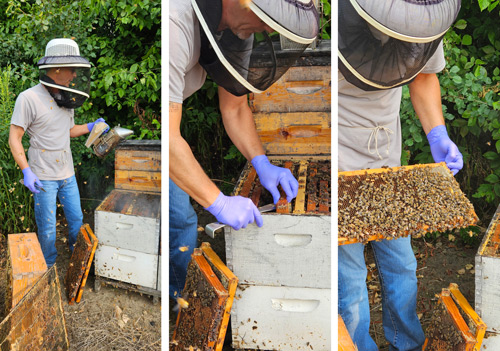
September 8, 2025 — You might not think twice about shooing that bee away during your backyard barbecue, but did you know that bees are responsible for about 90% of the food we eat, through pollination? That fruit salad was made possible by bees.
“Honeybees, along with all pollinators, play a vital part in our ecosystem, not just locally, but globally,” said Kristopher Stevens, a PEF member and apiary inspector with the New York State Department of Agriculture and Markets. “Honeybees help to pollinate much of our landscapes in New York, creating biodiversity which in turn helps support other wildlife and their habitats.”
 Honeybees play a vital role in New York’s agriculture economy. Each year, thousands of colonies throughout the state pollinate more than $300 million worth of crops such as apples, watermelon, pumpkins, and other garden variety produce.
Honeybees play a vital role in New York’s agriculture economy. Each year, thousands of colonies throughout the state pollinate more than $300 million worth of crops such as apples, watermelon, pumpkins, and other garden variety produce.
According to Ag and Markets, New York is home to more than 60,000 bee colonies, while additional colonies are shipped in from other regions of the country to make up the remainder.
Stevens relocated to New York in 1995 and became friends with a migratory commercial beekeeper, which launched him into what has now been two decades of working with bee colonies.
“After several hundred questions about what these insects were capable of doing, everything from communication skills to producing honey, wax, and propolis, and their ability to cross pollinate by use of static electricity to collect pollen, I chose the apiary inspection position because I could not get enough of the bees and the knowledge that came with it and I thoroughly enjoy the experience of meeting other beekeepers,” he said.
As an apiary inspector, Stevens works with beekeepers in a 15-county area in central New York, ensuring the health of colonies and determining if beekeepers are in compliance with current state regulations.
He invited me to join him recently on one of his routine inspections and the work started immediately, looking for dead bees outside of colonies, an indicator of an unhealthy hive.
Surrounded by a steady stream of bees, Stevens used burlap smoke from a metal can to keep them calm as he opened a hive and explained the different parts – from where the queen resided and how she was kept inside, to the difference in male and female brood and the stages of honey production.
“If a colony is suspected of having a disease or pesticide exposure, we may collect samples to send for lab analysis,” he said. “We also offer suggestions based on current research and best practices on how to mitigate diseases and maintain healthy colonies.”
Apiary inspectors also collect data on the number of colonies and beekeepers across the state, especially important when dealing with diseases like American Foulbrood, a destructive, worldwide bacterial disease that infects and kills larvae.
“Though the paperwork isn’t as fun as opening the colonies, data collection is a valuable part of the job as this information is used to determine resource allocation for the department,” Stevens said. “I recommend that all beekeepers register annually with the department and become a member of a local or statewide club, as well as get inspected. The inspectors have the resources at hand to help, if needed.”
Ag and Markets also maintains a list of swarm catchers that provide bee removal services in New York, and a beekeeper club directory.
Fun fact: There are bee colonies atop the Javits Center in New York City. Check out this news feature from CBS New York featuring Queens-based Astor Apiaries and master beekeeper Nick Hoefly.
“Happy, healthy colonies are more docile to work with, tend to produce more honey and their overwintering success is much higher,” Stevens said.

